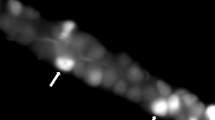Abstract
Prostaglandins and (PG) have been reported to be an important gastric acid suppressive factor. However, the mechanism underlying is yet to be clearly established. In vitro study with gastric microsomes in presence of both PGE2 and PGI2 shows a stimulation of gastric H+ K+-ATPase activity below 1X10−6M and 2.5X10−7M concentrations respectively. However, with further increase in concentrations of both PGE2 and PGI2, H+, K+-ATPase activity shows an inhibition but PGI2 completely obliterates the K+ stimulated part of H+, K+-ATPase activity at higher concentration. The H+-ion transport study using chambered frog gastric mucosa shows that both PGE2 and PGI2 inhibit H+-ion transport at 5X10−6 M and 10X10−6M concentrations respectively but the effect of PGI2 is reversible. These differential effects of PGE2 and PGI2 on microsomal H+, K+-ATPase and on H+ transport my be caused by the differential effects of these phospholipid mediators with the gastric mucosal cell membrane. This in vitro investigation shows the role of prostaglandin (s) as a physiological switch/regulator of gastric H+ ion transport leading to the cessation of gastric acid secretion.
Similar content being viewed by others
References
Robert, A., Nezamis, J. E., Lancaster, C. and Hanchar, A. J. (1979) Cytoprotection by prostaglandins in rats. Gastroenterol. 77, 433–443.
Lacy, E. R. and Ito, S. (1981) Cytology of prostaglandins treated rat gastric mucosa damage by absolute ethanol. Gastroenterol. 80, 1201–1205.
Shea-Donohue, P., Steel, L., Montcalm-Mazzilli, E. and Dubois, A. (1990) Aspirin-induced changes in gastric function: Role of endogenous prostaglandins and mucosal damage. Gastroenterol. 98, 284–292.
Miller, T. A. and Jacobson, E. D. (1979) Gastrointestinal cytoprotection by prostaglandins. Gut. 20, 75–87.
Soll, A. H. and Whittle, B. J. R. (1980) Interaction between prostaglandin and cyclic AMP in gastric mucosa. Prostagladin. 21 (suppl), 39–45.
Sarosiek, J., Slomiany, A., Takagi, A. and Slomiany, B. L. (1983) Hydrogen ion diffusion in dog gastric mucous glycoprotein effect of associated lipids and covalently bound fatty acids. Biochem. Biophys. Res. Com. 118, 523–584.
Ray, T. K. and Nandi, J. (1983) Regulation of the gastric microsomal (H+, K+)—transporting ATPase system by the endorgenous activator. Effect of phospholipase A2 treatment. Biochem. J. 212, 887–890.
Ray, T. K. (1978) Gastric K+—stimulated adenosine triphosphatase. Demonstration of an endogenous activator. FEBS Letters. 92(1), 49–52.
Lowry, O. H., Rosebrough, N. J., Farr, A. L. and Randall, R. J. (1951) Protein measurement with Folin phenol reagent. J. Biol Chem. 193, 265–275.
Bandyopadhyay, S., Das, P. K., Wright, M. V., Nandi, J., Bhattacharyay, D. and Ray, T. K. (1978) Characteristics of a pure endogenous activity of the gastric H+, K+—ATPase system. Evaluation of the role as a possible intercellular regulator. J. Biol. Chem. 262(12), 5664–5670.
Sanui, H. (1974) Measurement of inorganic orthophosphate in biological material: extraction properties of butyl acetate. Anal. Biochem. 60, 489–504.
Ray, T. K. and Tague, L. L. (1978) Role of K+stimulated ATPase in H+ and K+ transport by bull frog gastric mucosa in vitro. In: Proceedings from the Symposium on gastric ion transport. Sweeden, 1977, Eds. Obrink, K. L. and From, G. Acta Physiol, Scand. Special suppl. p. 283–292.
Song, Y. H. and Mardh, S. (1989) The occurrence of gastric and duodenal auto-antibodies in peptic ulcer idsease. Acta Physciol. Scand. 137, 535–539.
Wallace, J. L. (1992) Prostaglandins, NSAIDs and cytoprotection. Gastroenterol Clin. North Amer. 21(3), 631–641.
Ote, S., Takashasi, M., Yoshiura, K., Hata, Y., Kawabe, T., Terano, A. and Omata, M. (1993) Antiulcer drugs and gastric prostaglandin E2: in vitro study. J. Gastroenterol. 17 (Suppl 1), 15–21.
Lichtengerger, L. M., Graziani, L. A., Dial, E. J. and Butler, B. A. (1983) Role of surfaceactive phospholipids on gastric cytoprotection. Science. 219, 1327–1329.
Ray, T. K. and Fromm D. (1981) Cellular and subcellular aspects of the mechanism of gastric acid secretion. J. Surg. Res. 31, 496–505.
Scheiman, J. M., Kraus, E. R., Bonnville, L. A., Weinhold, P. A. and Boland, C. R. (1991) Synthesis and prostaglandin E2—induced secretion of surfactant phospholipid by isolated gastric mucous cells. Gastroenterol. 100, 1232–1240.
Author information
Authors and Affiliations
Rights and permissions
About this article
Cite this article
Bandyopadhyay, B., Bandyopadhyay, S.K. Role of prostaglandin in the regulation of gastric H+—Transporting system. Indian J Clin Biochem 13, 41–45 (1998). https://doi.org/10.1007/BF02873442
Issue Date:
DOI: https://doi.org/10.1007/BF02873442




